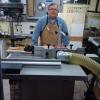My shapers don't have an integral sliding table, built into the main table. I just use bolt on versions and my new machine will have a side mounted version, but I'm wondering how folks deal with the fact that the sliding table is slightly proud of the rest of the table? Specifically thinking about where large diameter tooling is used and therefore pushes the stock out away from the spindle (and therefore closer to the slider and lip) such that wider sticking may end up partially on the main table and partially up on the slider? I can think of maybe a few ways out of it for short sticking but what about say passageway door stiles that want to partially ride on the sliding table, and partially not? Some machines may be large enough that the space is larger, but the smaller machines seem like this might be an issue,
TIA for thoughts,
B




 Reply With Quote
Reply With Quote


